Visit a community in Mexico where healthy mangrove forests anchor biodiverse ecosystems and local livelihoods.

20 / TRAFFICKING TAKEDOWN
22 / EYE OF THE WHALE

WINTER 2022
MAGICAL MANGROVES
Marvels of nature
I’ll never forget the first time I approached mangroves from the ocean. The first thing I noticed was an impossibly white yellow-billed cotinga nestled in the green branches. Then I slipped over the side of the boat, pulled on a mask, and snorkeled through the mangrove forest.
At first the experience was somewhat suffocating. The tangled roots of mangroves create a dark, murky world, with a myriad of plants and animals growing on and living among them.
Mangroves are good for the climate: They store three to five times more carbon per acre than tropical forests. Over 6 gigatons of carbon are held by mangroves worldwide, 87% of which is in the soil beneath their roots.
Mangroves also shield people from extreme coastal weather events, protecting lives and property from storm surges and flooding. They prevent erosion that destabilizes coastlines. They also provide livelihoods through fishing, honey harvesting, and more.
and, by 2030, restore half of recently lost mangrove area and double the current area of protected mangroves.
We’re also scaling up our efforts in four countries Colombia, Madagascar, Fiji, and Mexico where hundreds of thousands of people benefit from mangroves. There, communities and Indigenous groups, as well as local and national governments, are working to increase and strengthen climate-smart mangrove protection and management while improving people’s resilience. (Learn more on page 8.)
My oldest son and I traveled recently to Colombia, where we had the privilege of spending time with the Arhuaco and Kogi peoples, who believe in the study and understanding of nature as the basis of humanity’s survival. We marveled at a spectacular expanse of mangroves in the mouth of the Magdalena River.
I thought about the astonishing way mangroves survive in such brackish waters by filtering out up to 90% of the salt in the seawater entering their roots and how those root systems are where marine organisms lay eggs and raise their young. I left my inaugural experience appreciating these seemingly impenetrable coastal forests and all they do for the planet.
But being on the coast also makes these vital ecosystems vulnerable to development. Fifty percent of the world’s mangroves have been wiped out in the past half-century, and human activity is a primary cause.

In response, WWF has created the Global Mangrove Alliance with a host of partners to halt all further loss of existing mangroves
I am still reflecting on the wisdom of the Arhuaco and the Kogi. If we take the time to understand these trees, where sea meets land, where life begins, and where protection against disruption is provided, we cannot help but make them a priority in our global efforts to build resilience in the face of climate change.
CARTER ROBERTS PRESIDENT & CEO
PRESIDENT’S LETTER
© JASON HOUSTON/WWF-US
WINTER 2022
WWF’s mission is to conserve nature and reduce the most pressing threats to the diversity of life on Earth.
WWF’s vision is to build a future in which people live in harmony with nature.
president & ceo Carter Roberts
editorial director Alex MacLennan
publications director Sarah Forrest
managing editor Ananya Bhattacharyya
editor Erin Waite
editorial intern Julian Wray
EDITORIAL
senior editor Alice Taylor
editor, digital edition Alison Henry web producers Victoria Grimme, Isabelle Willson, Ellie Yanagisawa
contributing editors
Teresa Duran, Karl Egloff, Molly M. Ginty, Brie Wilson
contributing writers
Lauren Evans, Madeleine Janz, Stephanie Vermillion, Sara Curnow Wilson
ART
art direction and design
Page 33 Studio
consulting art director Sharon Roberts
PRODUCTION
production manager Mick Jones
volume 10, number 4 (ISSN 2330-3077)
World Wildlife is published quarterly by World Wildlife Fund, 1250 24th Street, NW, Washington, DC 20037. Annual membership dues begin at $15. Nonprofit postage paid at Washington, DC, and additional mailing offices.
learn more
Visit worldwildlife.org to learn more about World Wildlife Fund and what you can do to help. contact us editor@wwfus.org
© 2022 wwf. all rights reserved by world wildlife fund, inc. wwf® and ©1986 panda symbol are owned by wwf. all rights reserved.
Current financial and other information about World Wildlife Fund, Inc.’s purpose, programs, and activities can be obtained by contacting us at 1250 24th Street, NW, Washington, DC 20037, 1-800-960-0993, or for residents of the following states, as stated below. CONTRIBUTIONS ARE DEDUCTIBLE FOR FEDERAL INCOME TAX PURPOSES IN ACCORDANCE WITH APPLICABLE LAW. REGISTRATION IN A STATE DOES NOT IMPLY ENDORSEMENT, APPROVAL, OR RECOMMENDATION OF WORLD WILDLIFE FUND BY THE STATE. Colorado: Colorado residents may obtain copies of registration and financial documents from the office of the Secretary of State, (303) 894-2680, http://www.sos. state.co.us/ re: Reg. No. 20023005803. Florida: Registration # SC No. 00294. A COPY OF THE OFFICIAL REGISTRATION AND FINANCIAL INFORMATION MAY BE OBTAINED FROM THE DIVISION OF CONSUMER SERVICES BY CALLING TOLL-FREE WITHIN THE STATE, 1-800-HELP-FLA, OR BY VISITING https:// www.fdacs.gov/ConsumerServices. Georgia: A full and fair description of the programs and activities of World Wildlife Fund and its financial statement are available upon request at the address indicated above. Maryland: For the cost of postage and copying, from the Secretary of State. Michigan: MICS No. 9377. Mississippi: The official registration and financial information of World Wildlife Fund may be obtained from the Mississippi Secretary of State’s office by calling 1-888-2366167. New Jersey: INFORMATION FILED WITH THE ATTORNEY GENERAL CONCERNING THIS CHARITABLE SOLICITATION AND THE PERCENTAGE OF CONTRIBUTIONS RECEIVED BY THE CHARITY DURING THE LAST REPORTING PERIOD THAT WERE DEDICATED TO THE CHARITABLE PURPOSE MAY BE OBTAINED FROM THE ATTORNEY GENERAL OF THE STATE OF NEW JERSEY BY CALLING (973) 504-6215 AND IS AVAILABLE ON THE INTERNET AT http://www.state.nj.us/lps/ca/charfrm.htm. New York: Upon request, from the charities registry on the website of the New York Attorney General, Charities Bureau, 120 Broadway, New York, NY 10271. Information on charitable organizations may be obtained at or calling (212) 416-8401. North Carolina: Financial information about this organization and a copy of its license are available from the State Solicitation Licensing Branch at 1-888-830-4989 (within North Carolina) or (919) 807-2214 (outside of North Carolina). Pennsylvania: The official registration and financial information of World Wildlife Fund, Inc. may be obtained from the Pennsylvania Department of State by calling toll-free, within Pennsylvania, 1-800-732-0999. Virginia: From the State Office of Consumer Affairs in the Department of Agriculture and Consumer Services, P.O. Box 1163, Richmond, VA 23218. Washington: From the Secretary of State at 1-800-332-4483. West Virginia: West Virginia residents may obtain a summary of the registration and financial documents from the Secretary of State, State Capitol, Charleston, WV 25305.
1 WORLD WILDLIFE MAGAZINE 1 30
BABY ON BOARD
Locating important shark birthing sites
“Shark on the line!”
These words were music to Arjan de Groene’s ears as he bobbed in a boat in the Dutch Caribbean. After waiting an hour for a shark to take the bait, the WWF marine biologist and a small crew set to work performing an ultrasound on the female, fitting her with a satellite transmitter, and collecting DNA samples before slipping her back into the sea.
The team’s efforts were part of a study to assess the reproductive cycles of tiger sharks on the Saba Bank, a 1,034 sq. mi. national marine park with an extensive coral reef and abundant marine life. Their primary question: Do sharks use the protected area as a breeding ground?
During the weeklong expedition in August 2021, researchers from the Dutch Caribbean Nature Alliance, with support from WWF-Netherlands, caught and analyzed a total of 16 tiger sharks; of those, one was pregnant. They also satellite-tagged five sharks so they could track the animals’ migration routes.
De Groene says the overall study provided crucial insights about when and where the sharks breed and give birth data he hopes will help guide the creation of expanded protected shark sanctuaries and strengthen marine conservation policies across the Dutch Caribbean.

DISPATCH © DANIEL NORWOOD
SABA BANK :: DUTCH CARIBBEAN
TRAVEL WITH WWF REQUEST OUR NEW TRAVEL CATALOG
The new catalog allows you to explore nearly 90 inspiring, conservation-focused adventures for 2023 and 2024. When you travel with WWF through Natural Habitat Adventures, you join us as a force for change in addressing the most pressing conservation challenges around the world. Together, we are pioneering conservation travel, which supports the protection of nature, wildlife, and local communities. The well-being of the world’s most precious natural places is at the forefront of our work, and you can book with confidence knowing that you’re supporting WWF’s global conservation efforts.
Explore our collection of adventures on all seven continents, featuring flagship trips to Alaska, Botswana, Mexico, and the Galápagos:
+ Alaska Bear Camp / May–August
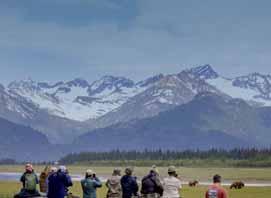
+ Secluded Botswana Safari / May–November

+ Kingdom of the Monarchs / December–February
+ Classic Galápagos: The Natural Habitat Experience / Year-Round
GET WWF’S TRAVEL CATALOG
Contact us at 888.WWF.TOUR (888.993.8687)
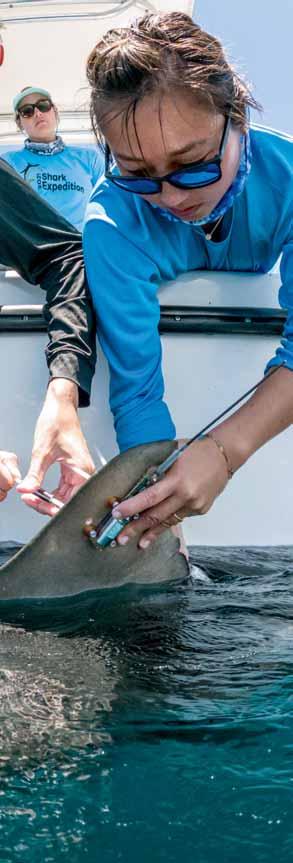
wwf.travel/catalog2023
WWF’s membership travel program is operated in conjunction with Natural Habitat Adventures. They have donated more than $4.5 million to date in support of WWF’s mission and will continue to give 1% of gross sales plus $150,000 annually through 2023.
©
COURT WHELAN/NAT HAB
Droughts, power cuts, and increased urbanization have affected Zambia’s energy sector in recent years, fueling a boom in charcoal production that’s contributing to widespread deforestation.
ZAMBIAN FOREST AMBASSADOR
Mwale Chishaleshale Mumba on protecting vital ecosystems

What inspires your work?
Witnessing the rate at which we are losing our forests has motivated me to focus my research efforts on how we can turn things around and use woodland ecosystems to mitigate climate change, with the local community involved.
Kitwe, Zambia
CAUSE
Mwale Chishaleshale Mumba has dedicated more than 15 years to conserving her country’s at-risk woodlands. Her experience spans work with WWF-Zambia, the Centre for International Forestry Research, and the Miombo Network, which promotes sustainable forest management in southern Africa. In 2021, she received a WWF Russell E. Train Fellowship, which will support her exploration of carbon trading as one potential solution to forest degradation.
Why is forest conservation critical in Zambia?
Apart from providing ecological services like air purification and wildlife habitat, forests are a source of livelihood, especially in rural and peri-urban areas. Communities source firewood and non-wood forest products, such as mushrooms and honey, and obtain wood for constructing their houses. As ecologists, we need to engage communities in sustainable forest management
How can carbon trading help?

One of Zambia’s main forest degradation activities, charcoal production, stems from communities’ need for income.


That’s why carbon trading, which compensates local communities for conserving forests, has a lot of potential. Basically, a carbon credit value is assigned based on how much CO2 a forest can absorb and store. Companies, governments, or individuals [seeking to] offset their emissions can purchase these carbon credits; they pay the community living in a forested area and the nation at large as long as that forest is conserved.
What are your main goals?
I want to carry the sustainable forest management and forest conservation agenda forward in my country and region. I want to lobby the government to push and integrate forest management mechanisms that promote conservation. Seeing measures such as carbon trading being taken up as forest management strategies is a great achievement for me.
4 WORLD WILDLIFE MAGAZINE
CHARCOAL © JAMES SUTER/BLACK BEAN PRODUCTIONS/WWF-US
HOME
A STAR IS BORN
The Australian peacock spider named after a colorful flap that resembles a peacock’s fan is currently experiencing its moment in the spotlight, all thanks to the internet. There were only seven identified species until 2011, when a video of one went viral and led to a flurry of interest and new discoveries. Now there are closer to 100.

PEACOCK SPIDER
genus Maratus

RANGE
Almost all species are found in the southern half of Australia, while one lives in China.
SIZE
About 1/16"–¼" long
DIET
Insects, other spiders
ABDOMEN In most species, males sport an opisthosomal flap with vibrant, elaborate patterns, which they unfold during their mating rituals.
EYES The spider’s eyes can perceive the full spectrum of color, including ultraviolet light useful for hunting and observing mates’ showy displays.

BODY Peacock spiders are covered in fuzz that gives them their bright hues.
LEGS Thanks to powerful legs with an internal hydraulic system, these spiders can jump up to 40 times their body length to attack prey or avoid predators.
MAY I HAVE THIS DANCE?
While each peacock spider species is physically distinct, scientists rely on their unique mating dances to distinguish between them. During these rituals, which can last nearly an hour, the spider uses vibrations—including one type known as rumble-rumps—and visual clues to attract the female. If the female isn’t pleased, she may kill the male.
STRANGER THINGS
Maratus speciosus
© JURGEN OTTO/PEACOCKSPIDER.ORG
KATMAI NATIONAL PARK AND PRESERVE :: ALASKA
IN FOCUS
Zooming in on Alaska’s wildlife
A half hour before midnight, the sun began to disappear behind the mountain peaks in Katmai National Park and Preserve. As daylight faded, coastal brown bears came out to feed. Thankfully, the bears weren’t interested in us, casting only an occasional glance as they feasted on marsh grass, sedges, berries, and the occasional clam, which they unearthed from the tidal flats using their enormous claws.

The last of the air taxis had already shuttled the day tourists back to civilization. Now it was just us and the bears. But our cruise ship’s tender was approaching the beach; we had time for just a few more photos, and I was determined to get a backlit photo of the female bear lumbering a dozen yards in front of me.
The previous week had been a blockbuster. I’d photographed a humpback whale breaching out of the water, a spry sea otter floating around Kodiak Harbor, a colony of puffins in flight over the Shelikof Strait, and a mama bear and three cubs cautiously navigating the marshes of Hallo Bay.
There was one last photo to nail. Everything was lining up perfectly. The light was ephemeral, and the bear was in just the right spot. Rule of thirds? Check. Narrow aperture for a starburst pattern? Check. Partially obstructed sun to reduce lens flare? Check. Focus. Breathe. Click. Keith Arnold
DISCOVER © WWF-US/KEITH ARNOLD
Want to discover Alaska with WWF? Visit worldwildlife.org/ExploreAlaska2022
When you take the simple steps to include WWF in your will or estate plan, you leave a lasting gift to conserve the species and natural places you care about. We all want to leave the world a better place, and a charitable bequest allows you to leave a legacy that reflects your deeply held values.

To learn more about how your gift can help WWF speak for nature for generations to come, please contact us today.
For more information, reach out to the Gift Planning Team at 888.993.9455 | legacygifts@wwfus.org or visit wwf.planmylegacy.org The

provided
is for educational purposes only and is not intended as legal or tax advice. Please consult an attorney or tax advisor before making a charitable
information
above
gift.
© RICHARD BARRETT/WWF-UK



































WORLD WILDLIFE
Mangroves are at the heart of one family’s— and entire communities’—sustainable way of life. Meet the Matas and learn about the many interconnections that allow both coastal ecosystems and communities to thrive.

As far back as Roberto Mata can remember, there have been oysters.
Since he was nine years old, Roberto says, he has spent his mornings and afternoons popping open the shells of the briny mollusks that, year after year, draw tourists from all over Mexico to his hometown of Boca de Camichín. And, he adds, it was thanks to those oysters that he became so talkative a skill that would help him achieve everything he has today.
Knife in hand, little Roberto would sit next to the diners at his family’s open-air beachside restaurant and open the mollusks in front of them. In that way, he could show how fresh the seafood was while asking and answering as many questions as possible. “Never for obligation,” he says, “but for joy.”
Today, Boca de Camichín is known as the oyster capital of the state of Nayarit for good reason. Dozens of stalls and restaurants with colorful facades line the entrance to the town. Shells adorn murals and hang on colorful ribbons to frame sand-floored gazebos.




 STORY BY HUMBERTO BASILIO
STORY BY HUMBERTO BASILIO














 BY NICOLE FRANCO
BY NICOLE FRANCO
9
PHOTOGRAPHY
HANGING OYSTER SHELLS © JASON HOUSTON/WWF-US


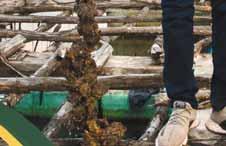


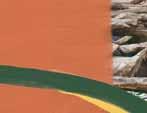


 RIGHT Kevin Perez, treasurer of the local oyster cooperative, holds a string of oysters on a floating pallet. Oyster farming depends on the unique water quality mangroves help provide.
INSET A freshly shucked oyster, which is known as the signature dish of his hometown.
RIGHT Kevin Perez, treasurer of the local oyster cooperative, holds a string of oysters on a floating pallet. Oyster farming depends on the unique water quality mangroves help provide.
INSET A freshly shucked oyster, which is known as the signature dish of his hometown.
BOCA DE CAMICHÍN SITS NEAR THE SOUTHERN EDGE OF
MARISMAS
NACIONALES NAYARIT BIOSPHERE RESERVE, WHICH CONTAINS
20% OF MEXICO’S MANGROVE FORESTS.
“The Marismas Nacionales region hosts the largest and most intact stretches of Mexico’s mangroves, and it is still relatively healthy because it continues to receive water from the upper part of the San Pedro Mezquital River basin,” says biologist Víctor Vázquez Moran, director of the protected area.
The hydrodynamics of Marismas foster the growth of mangrove forests in its more than 500 sq. mi. (approximately 133,000 hectares) of largely natural landscape and coast. The trees help regulate the climate, capture carbon dioxide, and act as natural water filters. They serve as a natural barrier against hurricanes and as nurseries for hundreds of species. The region is a vitally important human landscape as well, with more than 800,000 people relying on the benefits provided by the San Pedro Mezquital River.
In fact, the importance of the ecosystem services provided by the region to the entire Mexican Pacific coast led to its declaration as a Natural Protected Area in 2010.

And from the youngest to the oldest, the inhabitants of Boca de Camichín know that their subsistence depends entirely on the health of the reserve’s rivers, lagoons, mangroves, and marshes. WWF is committed to supporting their efforts to protect and improve their lives.
FAMILY DYNAMICS
At 8 am the bell rings at Boca de Camichín’s elementary school. While the children go to class and the restaurants prep for the day, dozens of oyster farmers board their boats and head for the estuary where the San Pedro Mezquital River flows into the Pacific Ocean. There, 500 harvesting rafts float almost static, surrounded by mangrove trees as far as the eye can see. On the horizon, the ocean swells.
It is the interaction of salt water and freshwater that allows mangrove forests to thrive and gives Boca de Camichín’s oysters their particular, sought-after flavor. In this quiet estuary, mangrove roots help maintain the perfect balance between salinity and freshness. The plants also harbor phytoplankton and generate the oxygen that oysters need to grow.
Oyster farming underpins livelihoods not only for Roberto’s family and the more than 30 people who work at the Matas’ restaurant, but also for the families of the 176 members of Ostricamichín, a local fishing and aquaculture cooperative. Around a third of the town’s population including multiple members of the Mata family is involved with mangrovedependent oyster aquaculture year-round.
“It’s a family job. Everyone gets involved,” says Ostricamichín’s president, Pedro Alfonso López. At the beginning of the season, the sons and daughters of the partners work on making sartas (long ropes on which around 30 mother shells are placed and where new oysters will begin to grow). In the following months, the
11 NAYARIT BOCA DE CAMICHÍN
wives and sisters monitor the oyster larvae as they grow to the size necessary for sale.
As the Ostricamichín families grow, needs also increase, explains López. This is why in 2017 the members of Ostricamichín started a small smoked oyster enterprise that will allow them to access new markets. Although they still need financial support, López is optimistic: In the newly built factory, all the oyster waste will be reused, reducing loss and improving production. “The plan is to make the business even more sustainable than it already is.”
Nevertheless, the past few years have been difficult for the cooperative. In recent seasons, the hydrological conditions have changed, affecting mangrove health and water quality. As a result, oyster production has declined: This coming season, the cooperative expects to harvest only 800 tons of oysters, when in the past they have brought in around 1,300 tons. “And with that,” López says, “half of the jobs could be lost.”
WATER WAYS
The impact of human activity along the 336 miles of the San Pedro Mezquital River is breaking the balance that the entire Marismas ecosystem needs to survive and it helps explain the drop in oyster numbers.


One of the most severe problems is water sequestration the removal of water from a natural system, like a river or lake, for purposes ranging from agriculture to aquaculture to human consumption. Another is the illegal construction of shrimp farms in the lower parts of the basin. In the biosphere reserve alone, Moran explains, there are 7,413 acres (3,000 hectares) of shrimp farms. And, while there are regulations in place to make their operations more sustainable, new production units continue to open illegally.
These unregulated, unsustainable farms siphon massive amounts of water from the river. Once the shrimp are harvested, the dirty water is deposited back into the river, dragging with it an excess of organic matter that ends up taking oxygen away from the mangroves, fish species, and mollusks that live in the lower river basin.
Since 2010, the National Commission for Natural Protected Areas (CONANP) and other federal agencies have been working to make

shrimp farming more sustainable. In addition, the reserve’s management is constantly monitoring Marismas to ensure that no new production units are established that have not complied with the law.


It’s essential to connect the dots between upstream water impacts and coastal ecosystems. The interdependence from zone to zone is high, says Ricardo Domínguez, water reserves officer for WWF-Mexico. “What happens in the upper and middle basin always has repercussions downstream.”
RIPPLE EFFECTS
About 20 years ago, the Matas’ restaurant began to feel the impact of declining fisheries.

12 WORLD WILDLIFE MAGAZINE
LEFT Julio Mata, cofounder of Experiencias Ecoturísticas Mata, or Ecomata, leads a tour through the mangroves.
RIGHT Husband and wife Eligio Mata and Rocío Barrón Rentería. Eligio is a cofounder of Ecomata; Rocío helps manage the family restaurant.
Realizing they would need another source of income, Roberto’s uncles, Julio and Eligio, and his father, Santos, started an ecotourism business they named Ecomata.


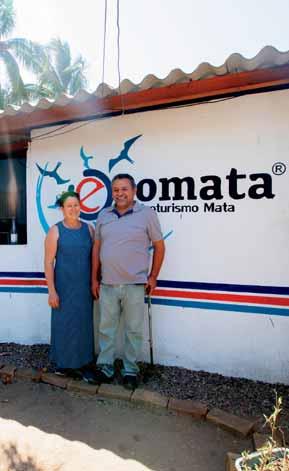
Roberto wanted in, so he took it upon himself to expand his understanding of tourism. At the University of Guadalajara, where he studied alternative tourism, he realized that his youthful experience guiding tourists through the mangroves and out to see whale sharks meant he could take his skills to any number of distant, tourist-heavy locations. But he never changed his plans: “I studied tourism,” he says, “to stay in Boca de Camichín, because I knew there was much to be done.”
His time away made him notice how things in Marismas were changing more than ever. “There is less rain and more hurricanes,” Roberto says. “But the mangroves continue to protect us,” he adds with a smile.



In the past three years, several cyclones have hit the Pacific coast, with both immediate and long-term impacts on Boca de Camichín. Residents say that the storms are increasingly hitting farther north, along the central coast of Marismas, and that this change in weather patterns is accelerating the flow of sediment downstream.
Claudia Teutli Hernández, ecological restoration specialist at the Center for Research and Advanced Studies (CINVESTAV), explains why this matters: Although the transport of sediment from the upper to the lower part of the basin is important because it carries with it nutrients necessary for ecosystem health, excess nutrients have a serious impact on the mangrove system.
When sediment accumulates, she notes, the wetland veins that carry water to the mangroves get clogged, and the mangroves don’t have the flooded periods they need to grow.













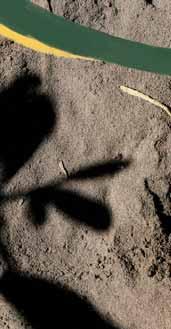



14 WORLD WILDLIFE
ABOVE Rafael Mata prepares plaster to make a cast of a jaguar’s paw print in Marismas Nacionales Nayarit Biosphere Reserve. He is a member of the Jaguarundis, a team of local volunteers who support biodiversity monitoring.
BELOW Paw prints are measured and their location noted before a cast is created.
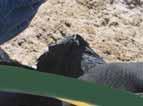


The result? Some mangroves are drying out. Understanding the implications of these water flows led WWF to develop hydrological monitoring maps of the lower-middle stretch of the river. The data helps communities, and partners like WWF and CONANP, identify where to implement assisted natural regeneration plans in coordination with the communities and the federal government.
In Francisco Villa an upstream community where ill-advised water projects led to massive mangrove die-offs resident Óscar González and other inhabitants use shovels to clear waterways and open canals to allow the water to reach the mangroves and let the little sprouts grow again. “Francisco Villa is a shrimping community, and without the mangroves,” says González, “we would have nothing.”
The Mata family has noticed another change in the ecosystem: invasive species. Just as excess salt water degrades the mangroves, excess freshwater affects the natural balance. When there is too much freshwater often the result of torrential rains in the upper basin the door opens to other threats, such as the proliferation of nonnative species in the wetland.
On a boat tour deep within Marismas’s natural, mangrove-lined channels, Julio Mata, a gregarious, playful guide, stops the engine and points quickly to the right. A long branch hugs the mangrove foliage, and although it seems to adorn it, the reality is different. “There’s the tripa de zopilote,” Julio says.
The plant that drapes the mangroves, also called a princess vine, is invasive. As freshwater infiltrates normally brackish areas, tripa de zopilote absorbs the freshwater and grows over the mangroves, preventing the endemic plants from carrying out the photosynthesis process. In essence, what looks like a lace drape over the mangroves is actually cutting them off from the nutrients they need. And when the newcomer gets big enough, it weighs the mangroves down until they are submerged.
A few meters ahead, a dry islet stands in the water. Like the princess vine, the seeds of common reeds have arrived from the upper basin and lodged among the mangroves, stealing nutrients and gaining ground.
CONANP staff estimate that between 750 and 900 acres of mangroves have been invaded.



15
Eradication programs have been implemented, but they need to be consistent to tackle the problem. “You clean,” says Rosario Medina, from Boca de Camichín, who has worked on the programs, “then come back after 15 days, and the vines are back again.” Eradicating invasives is just one area where WWF may increase local support.
Because of the mangroves’ extreme dependence on water balance, it’s necessary to link their conservation with the water reserve’s goal of protecting the river basin’s ecological balance and flows, says WWF’s nature-based solutions coordinator Pilar Jacobo. “If we don’t ensure that the water coming from the upper basin of the river continues to arrive, the restoration plans will be useless.”
MANGROVES, PEOPLE, AND MORE











The last stop on the Ecomata tour after seeing oyster farmers in action, looping through miles of striking green mangrove walls rife with bird life, visiting an island community with brightly colored colonial buildings, and scanning the ocean for wildlife is a biodiversity hotspot called Vuelta de Barreto. Rafael Mata, Julio’s son and Roberto’s cousin and perhaps the quietest member of the Mata clan, is the first to get off the boat. He knows the place well.
He points to the tree where he, his father, and his grandfather, Rafael “El Güero” Mata (for whom he is named), used to sit down


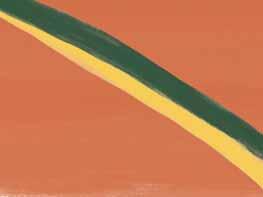

to rest after spending hours fishing in the reserve. Past the tree, a short path leads to a wide-open, packed-soil clearing that’s important to one of Rafael’s present-day occupations: monitoring jaguars.
In 2008, a group of residents alerted CONANP that they had sighted footprints of what has become the reserve’s flagship feline: the jaguar. This species had not been monitored for more than 50 years because for a long time, the Marismas Nacionales region was a hunting area; most people believed the big cats were locally extinct.
A year later, CONANP formed a monitoring and surveillance group made up of experts and people from different parts of the reserve who had previous experience and useful skills for the job, and Rafael was among them. Thus, “Jaguarundis” was born.

16 WORLD WILDLIFE MAGAZINE
Family is at the heart of efforts to protect the mangrove ecosystems that surround Boca de Camichín. Above, Enedina Cejas Garcia, the matriarch of the Mata family, holds a photo of her late husband, “El Güero,” the man whose legacy guides much of the family’s work.
In 13 years of work, the Jaguarundis staff of 10 has monitored 36 jaguars using camera traps and estimated their size and weight by modeling pugmarks in the wetland mud.
Rafael reaches down and frees a plaster cast of a jaguar’s paw. It’s larger than his hand. “I’m going to keep doing this as long as time permits,” he says.
The monitoring work carried out by CONANP, nonprofits, and the Jaguarundis is a great opportunity to advance WWF’s larger jaguar conservation strategy, which aims to secure a continental network of landscapes where jaguars, their habitats, and the ecosystem services they provide can survive well into the future. Places like Vuelta de Barreto and Marismas provide much-needed connectivity between priority areas for the big cats.
“Without the communities, we can’t do the work,” says Gabriela Delgadillo, a CONANP field technician who helps guide the Jaguarundis’ work. “Community input is the foundation on which the sustainable use of resources is based.”
THE BIG PICTURE
Because of mangroves’ critical value to people, wildlife, and the climate, WWF launched the Mangroves for Community and Climate (MFCC) project in late 2020. For more than a year, consultants and WWF staff have conducted conversations and interviews with residents of coastal communities such as Boca de Camichín to gain an understanding of local peoples’ immediate needs and of the conservation and restoration initiatives that can be strengthened to protect the ecosystem on which they depend.
The five-year project also seeks to reinforce local governance and decision-making about conservation and climate change adaptation. In coordination with the state governments of Nayarit and Yucatán, CONANP, and agencies such as the United Nations Development Programme, the MFCC project aims to support Mexico’s transition to a sustainable, inclusive, and climate-resilient development approach one that, says WWF’s Jacobo, “puts people at the center and leaves no one behind.”
To that end, a fundamental element of WWF’s work is to identify the best way to support community conservation enterprises such as Ostricamichín and Ecomata locally run projects that depend on the vitality and beauty of the mangroves to thrive.
For Jacobo, learning from people like the Matas and members of Ostricamichín will help WWF advocate with institutions and educate decision-makers on more sustainable public policies. “The main objective is to bring nature back through mangroves,” she says, ensuring that degraded mangroves are restored or under enhanced protection by 2025. “Our goal is to slow climate change while positively impacting a total of 235,000 people through the improved ecosystem services mangroves provide.”
LEGACIES
Back in Boca de Camichín, after a long day of work, Roberto, Rafael, and the rest of the Mata family sit at the restaurant table closest to the beach. Plates of ceviche, shrimp empanadas, and the family’s famous oyster chimichangas flood the space with mouthwatering smells.
Nearby, Julio sits down to rest and watches the rays of the sunset pass through the strings of oyster shells that adorn the border between the restaurant and the beach. A few meters away, his granddaughters play ball just as he did when he was a child.
With a sigh, he takes off his ever-present black cap, and a barely perceptible snip of embroidery peeks out the silhouette of Güero Mata’s face. “It is the way to always remember him,” he says. “He shaped who I am.”
Julio says his father taught him everything he knows. He has tried to pass that on to his family as well. He hopes that someday his grandchildren will have the opportunity to work at the restaurant or at Ecomata, the businesses the family has built with so much effort.
“My dad’s pride was always his family,” Julio says as he looks at his cap. “It would be sad if we couldn’t offer that to our grandchildren, too.”
To learn more about WWF’s work to protect mangroves around the world, go to worldwildlife.org/Mangroves2022
17
YUKON :: CANADA OUT ON THE TOWN Urban foxes own the night

At nearly 2 am on a rainy summer evening in 2020, I made my way to downtown Whitehorse, the capital of Canada’s Yukon territory, and placed my camera in a fox family’s den. I set up some lights and waited for the right shot, praying that the foxes’ curiosity wouldn’t spur them to steal my equipment. Eventually these two kits started playing by the entrance of their shelter, and I clicked my remote shutter.
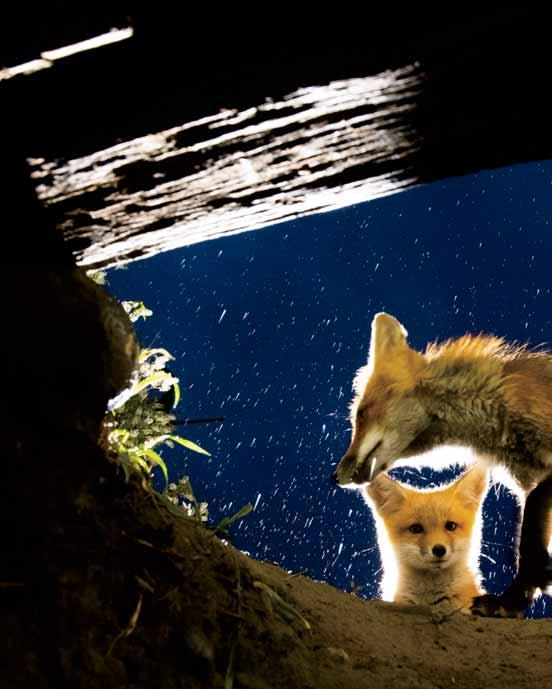
I was inspired to photograph these city foxes after one growled at me while I was walking my dog. I had never experienced aggression from them before, and I wondered if it was because I had come too close to their home. A couple of days later I found the many jagged entrances to their massive den under an abandoned building and started documenting their lives.
All my work is about encouraging people’s love of nature, but these photos proved to me that in order to protect wildlife, we must first recognize and cherish it. This shot in particular is a testament to how humans and wildlife coexist in Whitehorse, providing an example of how we could live in harmony with wildlife all over the world.
Peter Mather
CAUGHT IN THE ACT
NATURE NEEDS PARTNERS

NATURE NEEDS YOU
Partners in Conservation is a community of committed people working together to create a brighter future for wildlife, people, and our planet. By pooling your contributions with those of other Partners, you ensure a greater impact as WWF works to protect the species and habitats that sustain and inspire us.
With either an annual gift of $1,000+ or a monthly commitment of $100+, you join a diverse community of Partners driving global change together.
As a Partner in Conservation, you enjoy a closer relationship with WWF through special Privileges of Partnership, including
ACCESS—Hear directly from WWF leaders and experts; have a personal liaison answer your questions.
IMPACT—Get personalized updates on how your gifts advance our shared conservation goals. COMMUNITY—Network with your fellow Partners in Conservation at exclusive events.
Help create a healthier planet for wildlife and people.
Become a Partner in Conservation.


19
CONTACT OUR PARTNERS IN CONSERVATION TEAM TODAY. 800.960.0993 partnersinfo@wwfus.org worldwildlife.org/partners © PETER MATHER
© MCDONALD MIRABLE/WWF-US
BY THE NUMBERS
Stopping Digital Wildlife Trafficking




You can find almost anything on the internet—including illegal wildlife. These days, technology has made it easier than ever to traffic illicit live animals like tiger cubs, rare parrots, and prohibited reptiles, all of which are regularly sold as exotic pets. Meanwhile, products derived from species such as elephants, pangolins, and jaguars—ivory figurines, traditional medicines, pelts, and more—are readily available for purchase online.
The good news: Leaders in the tech sector, including eBay, Meta (Facebook, Instagram, etc.), and TikTok, have come together to tackle the issue. Convened by WWF, TRAFFIC, and the International Fund for Animal Welfare, the 47 companies in the Coalition to End Wildlife Trafficking Online seek out and remove illegal posts from their platforms. Coalition members train staff, block keywords,
Pangolins are the world’s most trafficked mammals, often poached then sold online to meet demand for their skin, scales, and meat.





Number of online posts selling prohibited wildlife that were blocked or removed by the Coalition to End Wildlife Trafficking Online between March 2018 and September 2021.



adjust detection algorithms, and strengthen prohibited content policies. Companies get their users involved too, by running education campaigns on social media and encouraging users to report suspicious posts.



Together, these companies are scaling up efforts to identify wildlife traffickers, halt illegal sales, and prevent the poaching that’s driving countless species toward extinction.

20 WORLD WILDLIFE MAGAZINE Filters Results: 11,600,000 Blocked Removed animals + animal products PANGOLIN © ISTOCK.COM/2630BEN 0
11.6 MILLION
COTTON COLLECTIVE
Pakistan is among the world’s top producers of cotton, a crop often cultivated using harmful pesticides and fertilizers. To make cotton production more environmentally friendly and improve farmers’ lives WWF-Pakistan in 2008 became a partner of the Better Cotton Initiative (BCI), which set a global standard for sustainable cotton. Today, nearly a quarter of the global cotton crop is produced using BCI or equivalent standards.

1 BETTER INPUTS

The family of Irum Shehzadi (right) is one of 250,000 Pakistani households working with BCI, which helps growers reduce their use of synthetic fertilizers and pesticides, optimize freshwater usage, and implement improved management practices.
2 FARM TO FIELD
Sarfaraz Bati holds a cotton boll. He took part in a WWF workshop on improving soil health by making fertilizer from livestock waste.
3 FOOD SECURITY
Thanks to a WWF training on kitchen gardening, families like Ramzana Bibi’s, whose livelihoods come largely from picking cotton, had access to nutritious food even when COVID-19 stopped them from working.
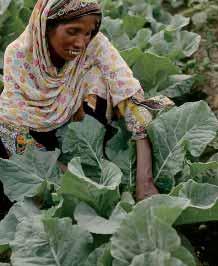

4 FOREST SMARTS
Shehzadi began a micro nursery with seeds provided by WWF. Saplings she grew were used in reforestation efforts that increase carbon absorption and build climate resilience.

Recent floods have affected around 33 million people in Pakistan. To learn more about the situation, visit worldwildlife.org/
PakistanFloods2022
21 © MATTIEU PALEY 1 4 2 3
FIELD NOTES
PUNJAB :: PAKISTAN
GALLERY
Giants, Jem Cresswell
When Australian photographer Jem Cresswell slipped into the waters around the Tongan archipelago with a camera and a snorkel, he focused on slowing his heart rate. He knew that if he remained still and calm, the curious humpback whales that migrate to the region annually would approach him. Cresswell grew up photographing surfers but turned his talents to these graceful mammals in 2014, using his lens to capture intimate black-and-white portraits of whale behavior. With his photos, collected over five years and compiled in his 2020 book Giants, Cresswell aims to “take people into the water with the whales and bring them eye-to-eye.”

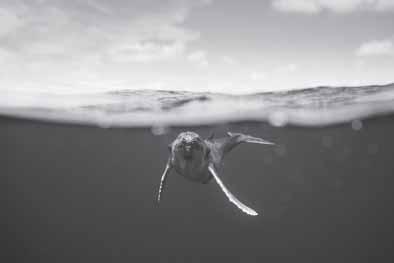
22 WORLD WILDLIFE MAGAZINE
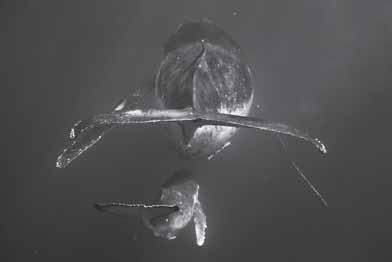
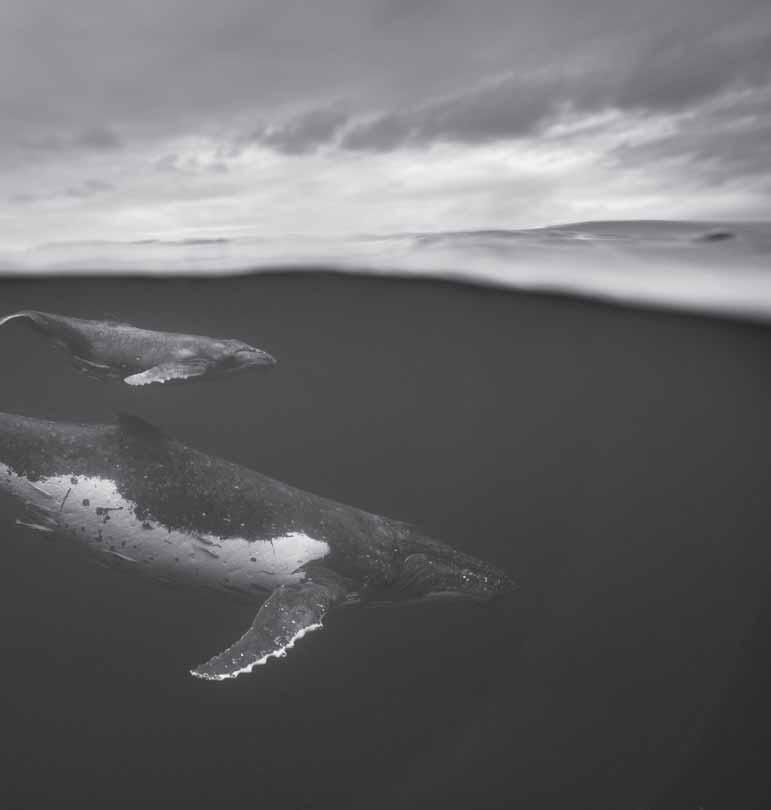 (Top)
GIANTS #1
(Bottom, left to right)
GIANTS #32
(Top)
GIANTS #1
(Bottom, left to right)
GIANTS #32
23
GIANTS #84
CELEBRATING, WITH A TWIST
Raise funds for nature with your next special occasion

Have a birthday coming up? A graduation? An anniversary? Whatever the occasion, consider asking for donations to WWF through Panda Nation in lieu of gifts a fun way to celebrate the big moments in your life while making a positive impact on the Earth.
Panda Nation is a fundraising platform designed so anyone can raise money for WWF. Take Kelly Brasseau, for example, who had to postpone her wedding due to the pandemic. “When I saw WWF’s 5K for Nature, I thought this would be the perfect way to turn our disappointment into something fun and positive,” she says. The couple engaged family and friends on social media during a hike on what would have been their wedding day and raised money for WWF.
Intimidated by the idea of fundraising? Don’t be. Most people are surprised by how easy the process is. And Panda Nation will support you and provide all the tools necessary to make your campaign a success. The best part: You get to share your passion for the environment with others and you may even inspire them to do the same.
wwf.help/fundraise2022
THE TAKEAWAY
© CHRIS GASH/WWF-US
Want to explore Panda Nation? Visit
WANT MORE?
Find expanded content from this issue of World Wildlife on our magazine website at worldwildlife.org/magazine.

LIQUID GOLD
In the Sundarbans mangrove forest, WWF-supported apiaries are decreasing the risk of tiger-human conflict and providing a safer, more lucrative alternative for people who gather wild honey for their livelihoods.

GIVE A GIFT THAT GIVES BACK
This holiday season, WWF has the perfect way to express your love for friends and family while protecting wildlife and the environment. Donate through WWF’s gift catalog and choose from many great thank-you items.
BOARD REPORT


Journalist
Amanda Paulson knows the power of a well-told story.

CONVERSATION
To articulate the inherent value of nature, Drew Lanham looks beyond data to poetry.
INQUIRY









Can feeding food waste to livestock reduce our environmental footprint?











Is there a fashionista on your list? Make a gift to WWF and help them spread your love for nature with wild socks in soft organic cotton. Choose from over 30 designs inspired by WWF’s conservation work around the globe. Sets of three pairs come in a special WWF logo sack.






This season, give something you can feel good about … in more ways than one!
UNIQUE GIFTS THAT GIVE BACK

For more information, please contact us at 800.960.0993
wwfcatalog.org/choose


25 DIGITAL
BEEKEEPER © TANMOY BADHURI/WWF INTERNATIONAL; COURTESY OF AMANDA PAULSON; BLACKBERRY BUSH © ISTOCK.COM/KAANATES; QUAIL © ISTOCK.COM/DSAMS; CHICKEN © ISTOCK.COM/SURIYA SILSAKSOM; GREEN BOWL © ISTOCK.COM/LYUDMILA MOISEENKO
THE MASTHEAD
What’s on the cover?
It’s the brightly colored face and bill of a whitethroated toucan, which is found in the Amazon basin.
JAGUAR

Panthera onca
For thousands of years, the jaguar has stood as an iconic cultural and religious symbol of power across Central and South America. Stealthy, agile carnivores with a powerful bite, jaguars will hunt just about any animal that crosses their path even making a meal of tapirs four times their size. And as predators at the top of the food chain, they help keep the ecosystem in balance.
But despite jaguars’ cultural and ecological significance, their numbers are falling. Prey to poachers for their rosette-spotted fur and other parts, the Americas’ largest cats are also threatened by deforestation and habitat degradation. To protect these felines, WWF and its partners are working to connect and conserve habitats across their range and to prevent human-wildlife conflict. Along Mexico’s western coast, those efforts involve safeguarding mangrove forests that sustain communities’ livelihoods, support climate resilience, and provide vital food and shelter for the majestic jaguar.
TOUCAN BEAK © SEBASTIAN DI DOMENICO JAGUAR © JOEL SARTORE/PHOTO ARK





































 BY NICOLE FRANCO
BY NICOLE FRANCO








 RIGHT Kevin Perez, treasurer of the local oyster cooperative, holds a string of oysters on a floating pallet. Oyster farming depends on the unique water quality mangroves help provide.
INSET A freshly shucked oyster, which is known as the signature dish of his hometown.
RIGHT Kevin Perez, treasurer of the local oyster cooperative, holds a string of oysters on a floating pallet. Oyster farming depends on the unique water quality mangroves help provide.
INSET A freshly shucked oyster, which is known as the signature dish of his hometown.




























































 (Top)
GIANTS #1
(Bottom, left to right)
GIANTS #32
(Top)
GIANTS #1
(Bottom, left to right)
GIANTS #32



















